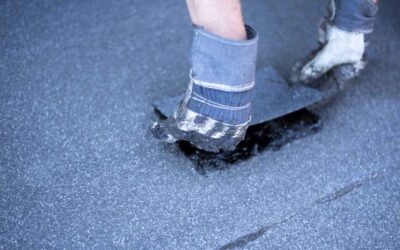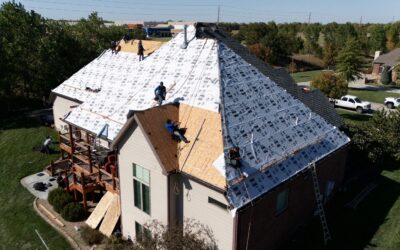Summary: Recommendation for Kansas Region
The typical premise for this question about dark shingles vs light shingles stems from concerns about the thermal efficiency of your home and effects of roof color in generating heat inside the building. This article discusses composite asphalt shingles, which cover roughly 80% of US homes and which come in a variety of colors ranging from ash to charcoal.
This topic is a highly regional topic because of climate and seasonality differences, and where we are located in the lower Midwest, there isn’t an obvious “right” answer. We go into much more detail below, but to skip to “the point,” we don’t believe differences in thermal efficiency make enough of a difference that you should pick a shingle color based on performance rather than aesthetic.
Our recommendation is clear; at least if you live in our climate region (Greater Wichita area), choose whatever color shingle you think will look the best on your home.
Introduction: Current Facts vs Old Beliefs
The discussion around shingle color did not stem out of nowhere. Darker materials reflect less sunlight, “absorbing” more radiant energy and heat than lighter materials. Surface temperatures of shingles do vary somewhat. The pattern of wariness in our region is typically toward dark shingles. Some of it is even founded in real data, from an era when both shingle technology and, more importantly, understanding of building science related to attic ventilation were not as good as they are today. Building codes and standard practice have changed dramatically since the 1980s.
A variety of anecdotal stories or maybe even valid complaints against dark asphalt shingles persist for a generation who was surrounded by preconceptions about roofing color and thermal efficiency which are now largely false or irrelevant. During an internal training with our own team, a long-time Roofing Specialist made the comment:
“Everybody used to push white roofs. 40 years ago, I’m sure it was believed at the time that it made a difference, whether it was true or not. Some people have even painted their shingles white [which by the way, is a terrible idea]. That was in a time when they had nothing but gable vents. Now of course, it just doesn’t make a difference.”
The Spectrum of Color Variance on Roofing Materials
Roofing material color is a much hotter (or cooler) topic in commercial flat roofing, in part because flat roofs do not ventilate the same way a sloped roof does, and in part because rolled roofing materials really only come in two colors – black or white. We have a separate article just on the topic of flat/rolled roofing materials Black Roofs vs White Roofs.
Which brings us back to residential, and one of the most relevant points we can make. This issue isn’t “black or white.” The vast majority of asphalt shingles are manufactured in neutral colors, so really we’re not comparing the difference between black and white, we’re talking about the difference between “walnut” and “aged wood.”
Specific Situations and Considerations
Again, our recommendation for this climate region is that shingle color is not significant to the thermal performance of your home. But perhaps people in these situations might want to read on:
- Vaulted or cathedral ceilings, especially in older homes with thinner rafter cavity/insulation depths
- Shed or garage roof with no ventilation or insulation between roof deck and main space
- Ice dams: If your home has locations particularly prone to ice dams
- Sensitive equipment in attic – satellite, mechanical, HVAC air handler or similar
- Roof Orientation: Roofs that receive more direct sunlight may have higher impacts from variance in color/radiation absorption
- Shade: The amount of shade from trees or nearby buildings can affect your roof’s sun exposure and, subsequently, the impact of shingle color on thermal efficiency.
- HOA or covenant community guidelines – may have requirements about the type and color shingle you can use. Check with community bylaws, if your neighborhood has an established local governance
We have formatted this article in terms of frequently asked questions we get from customers:
Regional Climate and Seasonality: Thermal Needs of Your Attic
In all climate conditions, heat (including heat generated from the surface of your roof) draws air through a conventional attic space as warm air rises. Air leaves through exhaust vents, drawing replacement air into intake vents low on the roof or soffit. This circulation is needed to remove humidity and prevent mold or condensation issues.
- Hot Climates: Dark-colored shingles tend to absorb more heat, potentially leading to increased indoor temperatures if attic ventilation is inadequate. This could result in higher cooling costs.
- Cold Climates: In colder climates, dark shingles can help with snow and ice melting due to heat absorption, potentially reducing snow weight loads or the risk of ice dam formation. In cold conditions without snow present (remember, snow is a reasonably good insulator), a warmer attic from surface warming might mean less heat loss into the attic and lower cooling costs
Kansas has both warm and cold seasons, in roughly equal parts of the year, so these offset. In a house with proper attic ventilation, the thermal differences between shingle colors are negligible. However, even in a house where shingle color might make a difference, the effects are opposite in opposite seasons, and offset.
What Should I Do Instead To Optimize Heat/Cooling Performance of the House?
- Attic Insulation: Proper attic insulation and ventilation play a more substantial role in regulating your home’s temperature than shingle color. Focus on ensuring your attic is well-insulated and adequately vented.
- Air sealing: While an attic needs to vent, sealing the “air envelope” of your house between ceiling of the top floor and the attic can make a dramatic impact on thermal efficiency, especially in winter as warm air rises. This means sealing openings cut for lighting, electrical boxes, around bath fans, and the outside perimeter of any ceiling vents from HVAC ductwork. Air sealing is most often done with canned spray foam insulation (e.g. Great Stuff)
- Update or upgrade mechanical systems
- Primary equipment – modern units have much more efficiency, and technology has bounded in the last 20 years with the rising popularity of more-popular head pump systems, which are compatible to retrofit into ducted houses on traditional split AC and furnace systems.
- Duct cleaning – decreasing resistance and, as a secondary benefit, removing allergens and dust from your home
- Changing filters – even just this, regularly changing filters a few times a year can increase the efficiency of hour HVAC
- Duct insulation – if you have ductwork that runs through unconditioned spaces, it should be insulated – crawl spaces and attics, though sometimes across garages or breezeways
Are There Climate Regions Where Shingle Color Does Matter?
Potentially – although you tend to see different roofing types/styles/materials altogether. For example, talking about increased surface snowmelt of black/dark roofs might be relevant in the far north, but in general the roofs are just built with steeper slopes there, which has a dramatically larger impact on the snow shedding/snow load. In the Southwest United States, tile roofs dominate (see the section below on roof materials).
What About Resale Value of the Home?
Okay this particular question isn’t really something we get asked that much related to color, so it’s a bit of a planted question to mention it here. Our point here is that even if shingle color did make a difference in heating and/or cooling costs, the few dollars difference each year will amount to essentially nothing when considering the effect it might have on the resale value of your home. A roof that does not fit the siding color and/or overall style of the house could cause a house to go for less than the full value. When it comes to shingles, choose what you think looks best.
What About Snowmelt?
Higher surface temperatures of dark roofs do speed up snowmelt. In Kansas, this isn’t meaningful when considering roof color, because snow tends to melt off of all roofs fairly quickly. More importantly, we don’t get snow load depths that threaten structural integrity.
In a rare circumstance where ice dams are a problem, such as a north-facing roof slope that extends from over the insulated building envelope to an area outside (e.g. a porch or unheated garage, or large rafter tails), shingle color might offer limited assistance.
What About Thermal Impact of Other Roofing Materials? (Not Asphalt Composition Shingles)?
- Reflection-enhanced asphalt shingles. Several manufacturers make some version of an asphalt shingle designed to reflect solar light/heat. In our market in Kansas and the lower Midwest, these are unnecessary because of the dual seasonality (warm is good half the year while you’re heating your house). However, they may merit consideration in warmer climates for environmental reasons or (in extreme climates) financial investment where energy savings could offset the increased material cost
- Tile and shake roofs, which can (debatably “should” – though that’s a different topic) be installed over plank decking with space between the boards, and are water-shedding but more breathable structures. This is one of the reasons (along with architectural differences) that clay tile roofs are so abundant in the hot, arid, and sunny climate of the American southwest.
- Metal roofs install over purlins (spaced wooden supports). The impermeability of how the metal is installed makes it behave much more like an asphalt shingle/solid decking roof, dependent on ventilation to keep the attic cool. Metal itself acts as a radiant barrier from the Sun; however, this plays such and an insignificant role in attic or insulated building envelope temperatures that it didn’t even make the list in our detailed comparison piece about Asphalt Shingles vs Metal Roofing.
- Flat roofs – rolled flat roofing (usually seen in commercial applications) typically only comes in two colors: black or white – and flat roofs are not ventilated in the same way a sloped roof is. Therefore, this topic of color is a much bigger deal in flat roofing and regions of the country are predominantly one or the other. We have a separate piece just on this in our Commercial Materials Series – Black Roofs vs White Roofs.
The Bottom Line
While the color of your shingles can have a minor impact on your home’s thermal efficiency, it is generally outweighed by other factors like insulation, ventilation, and climate. In our region in the lower Midwest, the “benefits” of one or the other offset in the other season; e.g. summer savings mean winter spending. Finally, the variability between shingles is not “black and white” because the color palette of most shingles are neutrals, and there simply is not significant difference between gray and dark gray.
For all these reasons, the difference in energy savings between dark and light shingles is usually minimal and should not justify compromising your aesthetic preferences. If you do want to increase the thermal performance of your home, focus on proper insulation, ventilation, and selecting a high-quality roofing material
Ultimately, your choice of shingle color should align with your personal taste and the overall appearance you want for your home. Aesthetic satisfaction and curb appeal often have a more significant influence on your daily life than the subtle differences in energy efficiency.
This article is part of our ‘Residential/ Steep Slope Materials’ Series. Learn more about:
- Asphalt Composite Shingles
- Metal Roofing
- Wood/ Cedar Roofing
- Other
- Roof Component Materials
- Traditional “Organic” Felt vs Synthetic Underlayment: Which is better?
- What Is the Difference Between Open and Closed Valley Installation?
- Continuous Venting Ridge vs Static/Box Vents: Which is better?
- What Are the Benefits to a High Profile Hip and Ridge Shingle?
- What Is a Class 4 Rating? Who Makes That Determination?



